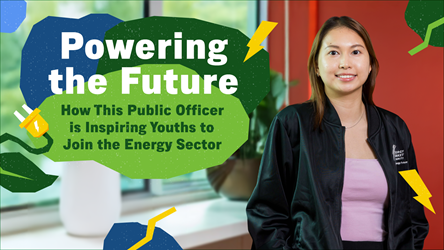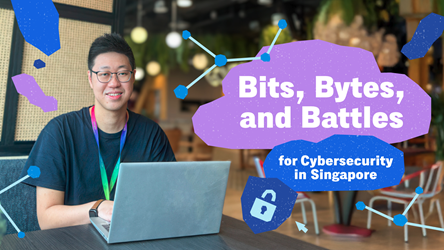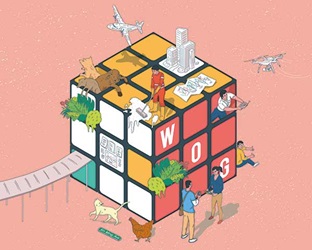Looking Out For All
.jpg)
Leaving no one out
Ms Fazlin Abdullah
Director, Advocacy & Research
National Council of Social Service (NCSS)
That made Ms Fazlin wonder how she could help children with special needs use the same playground as their typically developing peers. Play, says Ms Fazlin, brings about myriad emotional, social and physical benefits that all children should get to enjoy.
“Research shows that interaction in natural settings, and in particular play between children, with and without special needs, allows them to learn to accept one another’s differences and have comfortable social interactions with one another,” she says.
To come up with an inclusive playground, Ms Fazlin and her team at the NCSS held multiple engagement sessions with special needs schools and therapists to get input on which equipment children would enjoy and benefit from. They also pored through research on inclusive playground models overseas, and looked to play manufacturers producing equipment with inclusive features. Eventually, the playground was designed with eight new installations, each carefully catered for different special needs. They include wheelchair-friendly swings, and a merry-go-round that is level with the ground and has safety doors.
The first inclusive playground at Bishan-Ang Mo Kio Park was built in collaboration with the National Parks Board (NParks), who were instrumental in realising the vision of the inclusive playground, Ms Fazlin says.
For her, seeing children of varying abilities interact at playgrounds – the first time ever for several siblings – was hugely satisfying. The goal now is for 11 such playgrounds to be built across Singapore by 2018, in partnership with NParks and town councils.
While the inclusive process of creating the playground may have taken a little more effort, Ms Fazlin is thankful for the synergy. She says: “With concerted effort, close collaboration and a common goal, universal designs for persons with various needs can be implemented in our public spaces to foster a more inclusive Singapore.”

The art of inclusion
Mr Liu Yonglun
Manager, Arts Education
National Arts Council
.jpg)

As a manager of Arts Education at the NAC, Mr Liu Yonglun oversees the promotion of the arts in the special education sector.
In 2015, on a study trip in the US with a group of artisteducators, he discovered the concept of sensory-friendly performances for people on the autism spectrum, who have learning, sensory and social disabilities. These shows use less jarring sound and lighting so as not to over-stimulate those who are more sensitive to their surroundings.
It struck Mr Liu that many people with special needs never get to enjoy a performance with their families in a professional, purpose-built setting. A major obstacle is the lack of acceptance from other members of the audience, who may not tolerate any disruptive reactions.
Seeing the potential of sensory-friendly performances, Mr Liu set out to pilot Singapore’s first such full-fledged event. Roping in teachers from special needs schools and a music therapist, he worked with handbells group Ministry of Bellz to develop a show with unconventional house rules: movement was allowed during the performance, with lit aisles and lights partially dimmed (instead of a total blackout) for safety.
Pre-show activities allowed those with special needs to learn about and anticipate what the performance would bring. And in a positive precedent for similar events in the future, the venue host, Victoria Theatre, even designated a “calming room” for overexcited concertgoers.
Despite initial concerns, the project came to fruition in January 2016. The sensory-friendly show was sold out with two-thirds of the total 600 tickets going to families with children and family members with special needs. For many, it was their first time enjoying a performance together.
When a non-verbal boy with cerebral palsy burst into tears at the end of it, Mr Liu thought: “Oh no, is he upset because of the lights or the music?” But the boy’s teacher explained that he was emotional because he had not watched a concert before. He did not want the show to end.
Mr Liu hopes that this success would inspire other performing groups to hold sensory-friendly shows with mixed audiences. He adds: “This is also education for mainstream school students to understand why people on the autism spectrum exhibit certain behaviour, and to embrace diversity.”
The wheels have eyes... and ears
Superintendent Shng Yunn Chinn
Deputy Commander, Bedok Police Division
Singapore Police Force
.jpg)

Police cameras, installed mainly at the entrances and exits of multi-storey carparks since 2012, could not cover all areas. This impaired investigations on offences.
Meanwhile, Supt Shng and his team observed that more drivers were installing in-vehicle cameras. They realised that they could tap those extra “eyes” to supplement police cameras, at no extra cost, at the various decks of multistorey carparks, as well as open-air carparks.
That sparked Supt Shng to pilot the Vehicles-On-Watch programme at several carparks in the east in May 2014. Participating drivers leave their in-vehicle cameras running all day to help beat crime. The police can approach these volunteers for their camera footage to aid investigations.
One challenge was how to convince more residents to install in-vehicle cameras. The team believed that more would sign up if installing dashboard cameras was convenient for them. For the official project launch in 2015, the Police, with the Automobile Association of Singapore, invited a supplier to install in-vehicle cameras at discounted rates to drivers who signed up on the spot. It worked so well that the Police roped in more grassroots groups to extend similar on-site installations to other residential areas, including private estates. Today, the Vehicles-On-Watch programme has more than 1,500 volunteers with in-vehicle cameras across more than 100 carparks across Singapore, and a crime reduction of more than 33% in those carparks.
As a bonus, these in-vehicle cameras also serve as “extra ears” for solving crime, says Supt Shng. After a series of thefts in September 2015, it was an audio recording of the suspect’s voice from an in-vehicle camera – matched with police camera footage – that helped the authorities flesh out the suspect’s profile more accurately and nab the offender.
- POSTED ON
Feb 22, 2017
- TEXT BY
Fiona Liaw
- PHOTOS BY
Chuck Tham
- ART DIRECTION BY
Yip Siew Fei
-
Deep Dive
Aligning To Work As One









.tmb-tmb450x250.jpg)